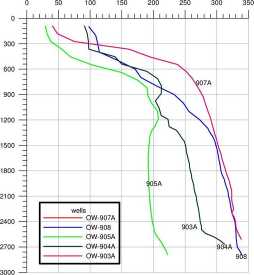5441336926
Report 8
69
Cherutich
TABLE 1: Comparison of thermal output of wells drilled with and without aerated fluids in Olkaria, Kenya (Hole, 2007b)
|
Wells drilled blind w ith water |
Wells drilled with aerated fluid | ||
|
Well No. |
Output (MWt) |
Well No. |
Output (MWt) |
|
1 |
43.31 |
A-l |
37.05 |
|
2 |
12.75 |
A-2 |
98.73 |
|
4 |
22.15 |
A-4 |
58.86 |
|
5(drilled with mud) |
14.75 |
A-5 |
105.49 |
|
6 |
21.38 |
B-l |
27.59 |
|
B-3 |
36.26 | ||
|
B-7 |
32.72 | ||
|
B-9 |
67.63 | ||
|
Average |
22.87 |
58.04 | |
3.6 Reservoir characteristics in Kenya
When selecting the kind of rig to use for drilling, the well design needs to be known and this in tum requires the reservoir conditions to be taken into consideration. This will help in specifying the size and rating of the mast and mud pumps.
3.6.1 Reservoir temperaturę
Temperaturę (°C)

FIGURĘ 3: Temperaturę logs for a few Olkaria wells
The reservoir temperaturę is obtained by direct downhole measurements or, for early wells, from geochemical estimates using geothermometers. In Olkaria the reservoir has a temperaturę >250°C at around 1,200 m depth. The formation temperaturę estimates help in designing the mud properties to contain the formation fluid coming into the wellbore to avoid a well kick, or cooking the drilling bit due to the lack of enough cooling from the drilling fluid used during drilling. Figurę 3 shows the dow nhole temperaturę of selected w ells in Olkaria. The data used was collected after the wells had heated up for morę than 40 days and some of them had also been discharged.
3.6.2 Reservoir pressure
The formation pressure can be around 170 bars at 2,700 m depth (Figurę 4).
This means that in such a well that has cold water, the static water level w'Ould be at 1,000 m. However, the average water level in a hot well around Olkaria is about 400 m below the surface. Thus, at a lower depth, aerated water is used to bring the cuttings to the surface for proper borehole cleansing, which means additional cost in running the compressors.
Wyszukiwarka
Podobne podstrony:
Tablica I. Porównanie cech elektrod zasadowych i celulozowych [2,3] Table I. Comparison of features
56 L. Berkowski 56 L. Berkowski Table 1. Comparison of the resulls of superplastic deformation at th
Report 8 75 Cherutich TABLE 3: Rig move statistics for the top drive and rotary table drive rig Ri
Report 8 77 Cherutich 4.9.1 The size of the well pad Before drilling commences, access roads, water
76 Ryszard R. Kaczyński Tabela 3. Porównanie programów studiów (lata I-III) Table 3. Comparison of a
120 Bunc V. J. Heller, S. Sprynarova, R. Zdanowicz. Comparison of the anaerobic threshold and mechan
Z BADAN W KALISZU KRZYSZTOF DĄBROWSKI REPORT ON THE FIELD RESEARCHES OF THE ARCHAEOLOGICAL ST ATI ON
StepperCompare COMPARISON OF THE 74194 - UNIPOLAR AND BIPOLAR STEP GENERATOR CONFIGURATIONS ©2003 RO
174 Gowen, L. K., Feldman, S. S., Diaz, R., et Yisrael, D. S. (2004). A comparison of the sexual beh
174 Gowen, L. K., Feldman, S. S., Diaz, R., et Yisrael, D. S. (2004). A comparison of the sexual beh
120 Bunc V. J. Heller, S. Sprynarova, R. Zdanowicz. Comparison of the anaerobic threshold and mechan
57307 P1170446 172 Janusz Osioja-Zagórsk 2 Ecxmom*c At the dechnr of the Btonze Age and even morę so
P1170446 172 Janusz Osioja-Zagórsk 2 Ecxmom*c At the dechnr of the Btonze Age and even morę so — in
essent?rving?61 C A R V E D MOULDIKCS Fic 4.17 Yarious examples of water leaf camed in limę wood, wi
CSG159 Unit 14Morę Uses of tlie Subjunctive: Adverb and Relative ClausesThe Suhjunetive in Adve
Page 26 Cognition, is the basis of both the teaching and the learning processes in Education. Theref
Ask Me Everything? Ninę incredible examples of animals that evolved and one that didn’t! I ■ In just
więcej podobnych podstron